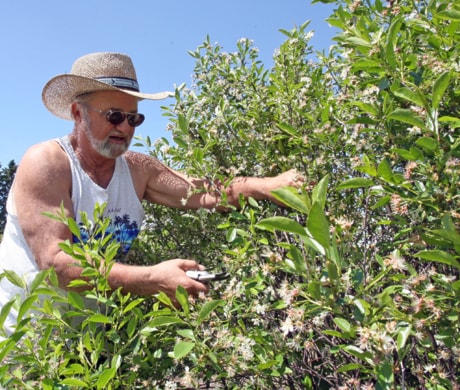When Pete Wasylyshyn retired, he left behind a positive legacy in Red Deer and some of them are rather tall and prickly.
The spruce trees that line for several blocks from the Black Knight Inn to Earls Restaurant on the east side of south Gaetz Avenue — that’s one of the many landscape designs that Wasylyshyn — now the owner of a unique orchard south of the city — can take credit for.
During his 20 years with the City of Red Deer from 1976 to 1996, he had a big role in planning parks. He was park planner until 1993 and then for three years with the Public Works Department he helped design the landscaping for the city landfill.
He was responsible for city park programs, including designing parks in some subdivisions that have existed for decades.
Later on, more help was hired but early on he did a lot of the planting himself.
Anyone who drives into Rosedale will see what Wasylyshyn has crafted, including the landscaped areas entering the east-end neighbourhood. He did that work from 1982 to 1984.
“Rosedale happened to be a city (developed) subdivision so we landscaped it,” Wasylyshyn said. “My last effort was the city landfill.”
His other landscape designs included planting patmore green ash trees along downtown sidewalk boulevards. He takes pride that they’re beautifying the area.
He also landscaped the original Anders Park, plus designed and landscaped the berm of tall poplars and spruce backing onto the former Civic Yards along Taylor Drive.
Wasylyshyn considered the desired end when choosing trees, shrubs or perennial plants for certain spaces. Wind protection? Winter and summer colour? Public use and safety?
“You wouldn’t want to use plants that could injure people — you think of the Russian pygmy caragana,” said Wasylyshyn, referring to the small spiny shrub. “You wouldn’t want to plant it around a children’s playground.”
He liked to use Theresa Bugnet rose because “I know she’s a tough one, she’s a good girl.”
“We used fall phlox, roses, tall Siberian iris, northern gem blackash — all of these are known to perform well,” Wasylyshyn said. “We knew we wanted to use the Swedish columnar aspen because it’s meant to break down the northeast winds coming into here.”
He’s watched his trees grow and for the most part they’ve done well. He’s noticed some spruce trees along Gaetz Avenue have turned brown. He wonders if it’s due to the salt on the road.
Wasylyshyn’s passion for horticulture — the science or art of cultivating trees, fruits, vegetables, flowers, or ornamental plants — led him towards an exciting initiative in Alberta.
He opened what he believes is the province’s only you-pick cherry and honeyberry orchard. Located on the farm he shares with wife Jan, Prairie Perfect Orchards is a short drive west of Innisfail, on Township Road 354 to Range Road 15.
They grow six varieties of cherries developed through the University of Saskatchewan to adapt to the cold.
Two varieties are tart and the other four have the same sugar level as B.C. cherries (two of these are the same size as B.C. cherries). One variety is low in sugar, so it’s good for processing for jams, as well as being good for diabetics.
In 2004, the couple started developing the orchards on former hay meadows.
“We’ve had some setbacks but by and large, they’ve done quite well,” said Wasylyshyn. “They are hardy and dwarf size, so we don’t need ladders to pick.”
The cherry trees, which when fully developed run 1.8 metres to 2.4 metres high, number about 850. Another 450 are waiting in the bullpen. Plus, there are about 300 honeyberry plants, and 10 varieties of apple trees and ample rhubarb.
Friends, relatives and hired part-time help give the Wasylyshyns a hand, normally from March through September. In the tiny shop, people can buy a wide variety of products from honeyberry jam to cherry sauce jelly.
Four acres of orchards are fenced so the deer and coyotes don’t get in.
The cherries are ready for picking over a four- to five-week period because the varieties develop at different rates. The University of Saskatchewan-developed honeyberries, similar to wild blueberries, are similarly hardy for this climate.
“The flowers can be hit with -7C and they’ll still produce fruit,” he said.
Wasylyshyn said even though he retired in 1996, he was ready to take on the challenge of growing an unusual crop.
“Plus, there was the fact that nobody else was doing it,” said Wasylyshyn, whose expertise in cherries has been sought by the University of Calgary and Olds College. “It was proven in Saskatchewan, which is way ahead of us in Alberta.”
Wasylyshyn, who describes himself as “old as dirt,” said it’s hard work. About a year ago, he and his wife tried to sell the property due to health reasons.
They’ve since launched Plan B, which is essentially seeking more help.
Wasylyshyn, who typically scoots around in a golf cart, said the orchard has become “more of a lifestyle.”
“We always welcome people and they don’t want to leave,” he said.
He remembers three visitors that came to the orchard and once they saw the hammocks underneath some trees, they hunkered down to relax.
“I think they had a nap,” Wasylyshyn said with a smile. “They got a bucket or a bucket and a half of cherries and then had something in the cafe (that offers light desserts and beverages) . . . we’re selling good will.”
The orchard opened the last week of June. Hours of operation are 11 to 5 p.m. Wednesdays through Mondays. It’s closed on Tuesdays. For more information, go online at www.prairieperfect.ca
ltester@www.reddeeradvocate.com
